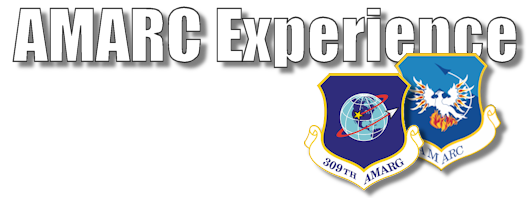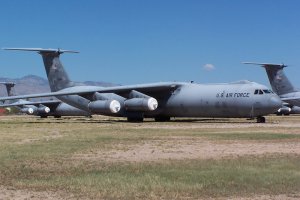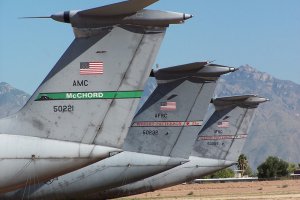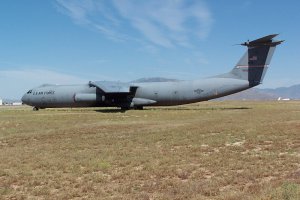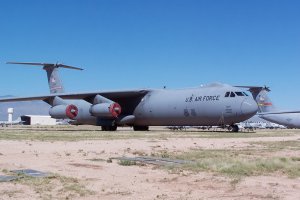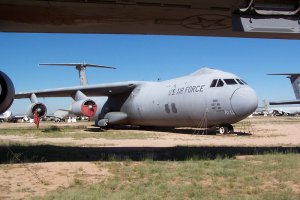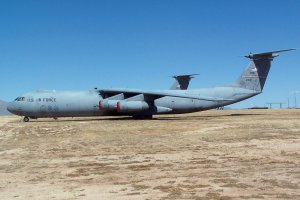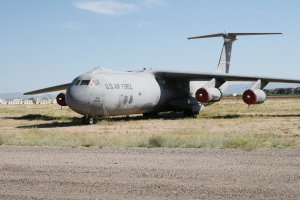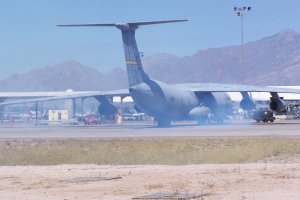The Lockheed Model 300 air lifter was designed in response to President John F. Kennedy’s first official act after inauguration: to develop an all-jet powered transport, to extend the reach of US military forces around the world. In March 1961 the C-141 was born. Using the same internal cross-section as its stable mate, the Lockheed C-130 Hercules (10 ft X 9 ft), the ‘StarLifter’ first took to the air on 17 December 1963.
Designed with a pressurized cabin and crew station, the C-141 is very versatile, able to be quickly converted to any of about thirty cargo or troop-carrying configurations. The C-141 can carry a variety of palletized cargo including most wheeled vehicles in the US inventory, as well as 205 passengers, or 168 fully equipped paratroopers. For medical evacuation, the –141 can carry 103 litter patients, or 113 ambulatory patients, or a combination of the two. Some C-141’s were modified to carry the LGM-30 Minuteman intercontinental ballistic missiles in their special containers.
The StarLifter participated throughout the war in Vietnam, making nearly daily trips to Southeast Asia with troops and supplies for the effort, and evacuating casualties back to the States. They were the aircraft that landed in Hanoi to return US POWs to America during 1973’s Operation Homecoming.
Early on, a major flaw was found in the StarLifter. It was discovered that the aircraft was volume-limited, that is, it was often fully loaded well before it reached its maximum weight limit. In the mid-Seventies, Lockheed proposed “stretching” the –141’s fuselage. Under an ambitious contract, 270 of the existing 274 StarLifters were fitted with two “plugs”, one forward and one aft of the wing, adding twenty-three feet to the fuselage length, as well as an in-flight refueling receptacle for extended range. The first converted C-141B took to the air in December 1979, and the conversion program was completed on 30 June 1982.
The StarLifter “stretch” provided a thirty percent increase in cargo capacity, or looked at another way, the increased length gave Military Airlift Command the equivalent of 90 additional aircraft.
Lockheed C-141C Starlifter tied down on its permanent storage spot within the AMARC RIT area. This aircraft served with the 452nd Airlift Wing at March AFB, CA. before retirement. © Phil Kovaric.
Three C-141C Starlifters in storage. 65-0221 from the 62nd Airlift Wing at McChord AFB, WA., and 65-0232 and 65-0256 from the 445th Airlift Wing at Wright-Patterson AFB, OH. © Phil Kovaric.
Lockheed C-141C Starlifter 65-0226 in longer term (Type 1000) storage in AMARC Area 3. This aircraft served with the 452nd Airlift Wing at March AFB, CA. before retirement. © Phil Kovaric.
Lockheed C-141C Starlifter 65-0237 on a temporary storage area shortly after its arrival at AMARC. This aircraft served with the 445th Airlift Wing at Wright-Patterson AFB, OH. before retirement. © Phil Kovaric.
The four -141's that were never converted to "B's" were the oldest StarLifters in service. They served at Wright-Patterson, and later Edwards AFB as test aircraft, the NC-141A's. These airframes, from the initial batch of StarLifters off the Lockheed production line (including the very first production C-141), were used throughout their careers for various test work, including projects for NASA and developing fly-by-wire systems for large aircraft. The last of the NC's was retired to AMARC on 7 August 1998.
Lockheed's StarLifter has participated in every major US action since 1964. The Cold War, Vietnam, and Operation Nickel Grass, the emergency airlift of arms and equipment to Israel during the Yom Kippur war in October 1973. Since 1974, C-141's have operated from Christchurch, New Zealand in support of Operation Deep Freeze, shuttling personnel and supplies to the Antarctic Continent. It was the StarLifter that brought the hostages home from Tehran, Iran in 1981.
The C-141 participated in Operation Urgent Fury in Grenada in October 1983, and Operation Just Cause, the invasion of Panama in December 1989, dropping paratroopers during each action. On 20 December 1989, StarLifters dropped 2,000 troopers over the Omar Torrijos Airport near Panama City, the largest airborne assault since World War Two.
Lockheed C-141C Starlifter 66-0158 tied down on its permanent storage spot, located within the AMARC RIT. This aircraft served with the 62nd Airlift Wing at McChord AFB, WA. before retirement. © Phil Kovaric.
Lockheed C-141C Starlifter 66-7959, being held on a temporary AMARC arrivals area. This aircraft served with the 445th Airlift Wing at Wright-Patterson AFB, OH. before retirement. © Phil Kovaric.
Lockheed C-141C Starlifter 67-0031 being held on a temporary AMARC arrivals area. This aircraft served with the 445th Airlift Wing at Wright-Patterson AFB, OH. before retirement. © Phil Kovaric.
A newly retired C-141C Starlifter undergoing engine preservation on the AMARC Flush Farm. © Phil Kovaric.
The shining moment for the StarLifter though, was during the Desert Shield buildup between August and December 1990. It was a StarLifter from the 437th Military Airlift Wing, Charleston South Carolina that brought the first US forces into Saudi Arabia, transporting an airlift control element from the 438th Military Airlift Wing out of McGuire Air Force Base to begin the oversight of the huge volume of airlift traffic coming in from the United States.
Over the next year, the StarLifter fleet flew the most airlift missions- 7,047 out of 15,800 in support of the war against Iraq, carrying more than 41,400 passengers, and hauling better than 139,600 tons of freight.
Following Desert Storm, Special Operations Command put Lockheed's StarLifter to use for covert ops as well. Thirteen examples of C-141B have received the Raytheon/E-Systems SOLL/SOLL II (Special Operations Low Level) modification, which added low-level penetration and self-protection systems to the airframe. Various "lumps and bumps" have sprouted on the fuselage, housing upgraded navigation/communication systems, Forward Looking Infrared (FLIR) turret, Radar Warning Receiver, and infrared and missile plume detectors.
The aging of the fleet through the Nineties and into the turn of the century became a major concern. The fleet was nearing the seven million flight hour mark. Following conversion to the 'B' model, airframe life was projected at 45,000 flight hours. Production delays of the -141's replacement, the McDonnell Douglas (now Boeing) C-17 Globemaster III, coupled with new USAF requirements for low-altitude penetration of strategic airlifters, had served to accelerate wear and tear on the StarLifter fleet. Wing cracks and other fatigue stresses had been discovered, far short of the projected airframe hour limits.
As a result, force reduction in active-duty Air Force units began. It was estimated that the StarLifter will be retired from the front line AMC wings by 2003. The "youngest" 63 airframes under went major modifications, such as the All Weather Flight Control System, (AWFCS) which incorporated a digital autopilot, advanced avionics displays, GPS, SatCom, and Ground Collision Avoidance System (GCAS). These airframes, the "glass cockpit" C-141C's, served with AFRC and ANG units through to 2004. The final flight made by an active service C-141 took place on September 16, 2004 when 64-0633 from the 305th Air Mobility Wing, McGuire AFB, NJ. retired to AMARC.
The proud career of Lockheed's Model 300 strategic airlifter came to its end on May 6, 2006 when C-141 66-0177, the famous 'Hanoi Taxi', performed its final flight at Wright-Patterson AFB, OH.
Specifications
General Specifications
| Powerplant | 4 × Pratt & Whitney TF33-P-7. 21,000 lb (93.41kN) dry thrust |
| Length (C-141B) | 168 ft 3.5 in (51.29 m) |
| Wingspan | 159 ft 11 in (48.74m) |
| Wing area | 3,228 sq ft (299.88 sq m) |
| Height | 39 ft 3 in (11.96 m) |
| Empty weight | 148,120 lb (67,186 kg) |
| Max. takeoff weight | 343,000 lb (155,580 kg) |
Performance
| Maximum cruise speed | 566 MPH (910 km/h) |
| Speed long range cruise | 495 MPH (796 km/h) |
| Ferry range | 6,390 miles (10,280 km) |
| Range max payload/unrefueled | 2,935 mi (4,725 km) |
| Max rate of climb - sea level | 2,920 ft/minute (890 m/min) |
| Service ceiling | 41,600 ft (12,680 m) |

